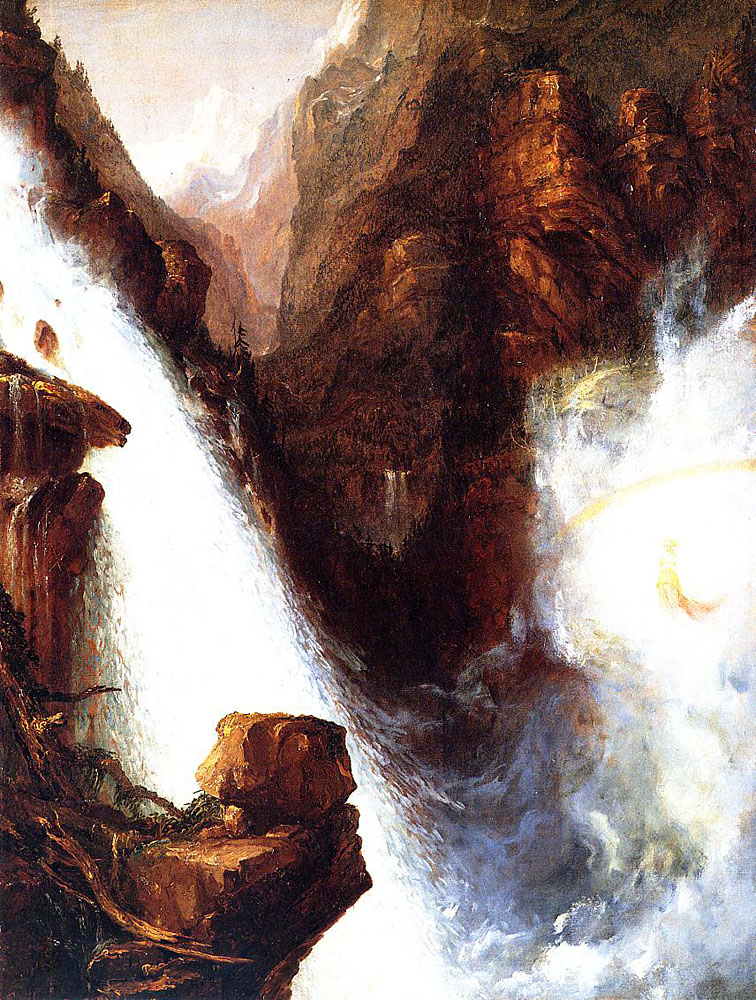And thou fresh breaking Day, and you, ye Mountains,
Why are ye beautiful? I cannot love ye.
And thou, the bright eye of the universe,
That openest over all, and unto all
Art a delight—thou shin’st not on my heart.
And you, ye crags, upon whose extreme edge
I stand, and on the torrent’s brink beneath
Behold the tall pines dwindled as to shrubs
In dizziness of distance; when a leap,
A stir, a motion, even a breath, would bring
My breast upon its rocky bosom’s bed
To rest for ever—wherefore do I pause?
Lord Byron's poetic drama, Manfred, begun in 1816 when he was living in Switzerland, was published two hundred years ago. Although its hero resembles Faust, the poem was, Byron claimed, more influenced by his impressions of the mountain landscape than his reading of Goethe. There are no lengthy descriptions of scenery in Byron's poem, just enough to convey a sense of the high peaks where it is set (the quotation above is from Act 1 Scene 2: 'The Mountain of the Jungfrau.—Time, Morning. MANFRED alone upon the Cliffs.') Instead, it is the entire poem that has the sublimity of the Alps, its themes of loss and despair echoing the spectacular but lonely isolation experienced on their heights. Reading Manfred reminded me that works of art infused with a spirit of place are far more numerous than the ones I tend to restrict myself to here, that describe the actual appearance of a landscape.
Thomas Cole, Scene from 'Manfred', 1833
Source: Wikimedia Commons
There is one reference in Manfred to a natural phenomenon that is based on what Byron saw on 22 September, 1816. He and his travelling companion John Cam Hobhouse were in the Lauterbrunnen Valley, looking up at the The Staubbach Fall. Byron wrote in his journal that the torrent reminded him of the tail of a pale horse, such as Death might ride at the Apocalypse. The next day they returned and Byron noted 'the Sun upon it forming a rainbow of the lower part of all colours – but principally purple and gold – the bow moving as you move – I never saw anything like this – it is only in the Sunshine.' These impressions were used to set the scene for Act 2 Scene 2, with Byron also including a footnote on the rainbow.
It is not noon; the sunbow’s rays1 still arch
The torrent with the many hues of heaven,
And roll the sheeted silver’s waving column
O’er the crag’s headlong perpendicular,
And fling its lines of foaming light along,
And to and fro, like the pale courser’s tail
The Giant steed, to be bestrode by Death,
As told in the Apocalypse.
1This Iris is formed by the rays of the Sun over the lower part of the Alpine torrents. It is exactly like a rainbow come down to pay a visit, and so close that you may walk into it. This effect lasts till Noon.
A rainbow in the Trümmelbach Falls
Photographed by me, August 2017
We were in the Bernese Oberland ourselves last month and observed one of these rainbows in a waterfall near the one Byron visited. We also ascended to the top of the Schilthorn, to look as he and Hobhouse had, across to the summit of the Jungfrau. Byron saw clouds gathering on one side - 'curling up perpendicular precipices – like the foam of the Ocean of Hell during a Springtide – it was white & sulphery – and immeasurably deep in appearance.' We picked a beautiful clear day, so clear that we could see Mont Blanc. The downside of this was that the summit was pretty crowded with other tourists. Even Byron could not enjoy the sight of the Jungfrau in solitude. 'Lying down for a few minutes to contemplate these wonders, Hobhouse and Byron were irritated by the sudden appearance of two or three female tourists on horseback when they had imagined they had the mountain to themselves' (Fiona MacCarthy, Byron: Life and Legend).
The Eiger, Mönch and Jungfrau
Photographed by me, August 2017
Byron's hero has to get away from other people: 'my nature was averse from life; / And yet not cruel; for I would not make, / But find a desolation.' Manfred thinks he is alone on the summit of the Jungfrau, but he too is disturbed - by the unexpected appearance of a passing chamois hunter. Death may be Manfred's inevitable fate at the end of the poem, but now, in its opening scene, this hunter prevents him from jumping into the void and leads him back down to safety:
The clouds grow thicker—there—now lean on me—
Place your foot here—here, take this staff, and cling
A moment to that shrub—now give me your hand,
And hold fast by my girdle—softly—well—
The Chalet will be gain’d within an hour.
John Martin, Manfred on the Jungfrau, 1837
Source: Wikimedia Commons




No comments:
Post a Comment